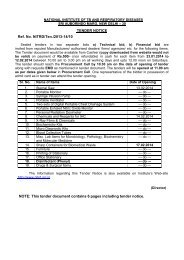The Indian Journal of Tuberculosis - LRS Institute of Tuberculosis ...
The Indian Journal of Tuberculosis - LRS Institute of Tuberculosis ...
The Indian Journal of Tuberculosis - LRS Institute of Tuberculosis ...
You also want an ePaper? Increase the reach of your titles
YUMPU automatically turns print PDFs into web optimized ePapers that Google loves.
20 A.K. CHAKRABORTYCTAL ETAL<br />
Use <strong>of</strong> the model<br />
<strong>The</strong> critical evaluation <strong>of</strong> DTP efficiency<br />
through the conscious selection <strong>of</strong> very high CF<br />
efficiency, compliance, and SCC coverages, as<br />
inputs, is certainly an optimistic projection. No<br />
doubt, with the present levels <strong>of</strong> efficiency inputs<br />
in case-finding, case-holding and treatment, it<br />
may appear impossible to postulate an annual<br />
reduction <strong>of</strong> cases equivalent to or more than the<br />
annual incidence. Hopefully,however, one could<br />
still expect a dent in the problem <strong>of</strong> tuberculosis,<br />
if only in a long time-frame. With that end in<br />
view, a model is separately being constructed to<br />
estimate the time frame required to observe a<br />
downward trend in the problem <strong>of</strong> tuberculosis<br />
under some <strong>of</strong> the alternative efficiency situations<br />
given above.<br />
Apart from the use <strong>of</strong> the present model in<br />
constructing the long term epidemiological time<br />
trend <strong>of</strong> tuberculosis, following programme<br />
interventions, realistic estimates <strong>of</strong> expectations<br />
given in this paper could be used to demonstrate<br />
the gains that could accrue by improving the<br />
efficiency <strong>of</strong> various programme activities.<br />
Programme planners and administrators could<br />
make conscious selection <strong>of</strong> some <strong>of</strong> the<br />
alternatives, <strong>of</strong> input-combinations given in Table<br />
7 in context <strong>of</strong> resources available, and expect<br />
commensurate results by matching with outputs<br />
given in the paper.<br />
References<br />
1. Srikantaramu, N., Baily, G.V.J., Nair, S.S. : An<br />
operational model <strong>of</strong> the District <strong>Tuberculosis</strong><br />
Programme; Ind. J. Pub. Health.; 1976, 20, 3.<br />
2. Radhakrishna, S. : National <strong>Tuberculosis</strong><br />
Programme - Relative merits <strong>of</strong> enhancing the<br />
operational efficiency <strong>of</strong> different components <strong>of</strong><br />
the treatment programme; Ind. J. Tub.; 1983, 30,<br />
3.<br />
3. Radhakrishna, S. : Direct impact <strong>of</strong> treatment<br />
programme on totality <strong>of</strong> tuberculosis patients in<br />
the community; Ind. J. Tub.; 1988, 35,110.<br />
4. Vandenbroucke, J.P. : Should we abandon<br />
statistical modelling altogether?; Am. J.<br />
Epidemiol; 1987, 126, 10.<br />
5. King, M.E., Soskolne, C.L. : Use <strong>of</strong> modelling in<br />
infectious disease epidemiology; Am. J.<br />
Epidemiol.; 1988,128, 949.<br />
6. Nagpaul, D.R. : District <strong>Tuberculosis</strong> Control<br />
Programme in concept and outline; Ind. J. Tub.;<br />
1967, 14, 186.<br />
7. Banerji, D., Anderson, S. : A sociological survey<br />
<strong>of</strong> awareness <strong>of</strong> symptoms suggestive <strong>of</strong><br />
pulmonary tuberculosis; Bull. Wld. Hlth. Org.;<br />
1963, 29, 665.<br />
8. Rao, K.P., Nair, S.S., Naganathan, N., Rajalaxmi,<br />
R.: Assessment <strong>of</strong> diagnosis <strong>of</strong> pulmonary<br />
tuberculosis by sputum microscopy in a district<br />
tuberculosis programme. Ind. J. Tub.; 1971, 18,<br />
10.<br />
9. Report on National <strong>Tuberculosis</strong> Programme.<br />
Period : Quarter July to September 1989.<br />
National <strong>Tuberculosis</strong> <strong>Institute</strong>, Bangalore-<br />
560003.<br />
10. Baily, G.V.J., Samuel, G.E.R., Nagpaul, D.R.:<br />
Concurrent comparison <strong>of</strong> an unsupervised selfadministered<br />
daily regimen and a fully supervised<br />
twice weekly regimen <strong>of</strong> chemotherapy in a<br />
routine out patient treatment programme; Ind. J.<br />
Tub; 1974, 21, 152.<br />
11. Jagota, P., Gupta, E.V.V., Parimala, N.,<br />
Shrinivas, T.R., Chaudhuri, K.: Operational<br />
feasibility <strong>of</strong> an unsupervised intermittent short<br />
course chemotherapy regimen in District<br />
<strong>Tuberculosis</strong> Centre; Ind. J. Tub. : 1991, 38, 55.<br />
12. Jagota, P., Sudha, X., Parimila, N., Chaudhuri,<br />
K.: A study <strong>of</strong> operational factors influencing the<br />
applicability <strong>of</strong> two regimens <strong>of</strong> Short Course<br />
Chemotherapy under conditions <strong>of</strong> an urban<br />
tuberculosis programme; Ind. J. Tub.: 1989, 36,<br />
.213.<br />
13. National <strong>Tuberculosis</strong> <strong>Institute</strong> : <strong>Tuberculosis</strong> in<br />
rural population <strong>of</strong> south India : a five year<br />
epidemiological study; Bull. W.H.O.; 1974, 51,<br />
473.

















